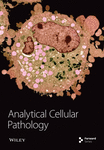Increased Cell Proliferation in Chronic Helicobacter pylori Positive Gastritis and Gastric Carcinoma – Correlation between Immuno-Histochemistry and Tv Image Cytometry
Abstract
Backgound: Epithelial cell proliferation activity has been reported both to be unaltered and increased in Helicobacter pylori (H. pylori) associated chronic gastritis. The proliferation rate decreased following H. pylori eradication, but results are controversial whether this change is dependent on the success of eradication. We compared the cell proliferation activity of H. pylori positive and negative gastric epithelial biopsies in chronic gastritis with and without intestinal metaplasia (IM) and gastric cancer by the expression of proliferation cell nuclear antigen (PCNA) and Tv image cytometry, and assessed the effect of H. pylori eradication on the cell proliferation rate in the gastric epithelium.
Methods: Brush smears and antral biopsies were taken from 70 patients (42 men, 28 women, mean age 58 ± 15 y.o.) on routine endoscopy. Patients were divided into four groups according to the histology; normal epithelia (n=10), chronic gastritis without IM (n=24), chronic gastritis with IM (n=20), and gastric carcinoma (n=16). Thirty-three patients were H. pylori positive, and success of eradication was controlled in 24 cases. Cell proliferation was measured by immunohistochemistry using PCNA labeling index (LI) and by Tv image cytometry evaluating 12 morpho- and densitometric parameters of each nuclei and 6 additional parameters of each smear.
Results: PCNA LI, DNA index and S + G2 ratio were all higher in chronic gastritis than in the normal epithelium, and were further increased in carcinoma. The lower PCNA LI observed in chronic gastritis with IM corresponds to the lower S phase ratio determined by Tv image analysis. In H. pylori positive cases, the proliferation activity was 69.3 ± 13.05% prior to the eradication and it decreased to 55.8 ± 23.31% after the successful eradication therapy. When immunohistochemistry was compared with Tv image cytometry, PCNA LI significantly correlated with the percentage of cells in G1 phase (r=−0.415) and S phase (r=0.385), Integrated Optical Density mean (r=0.598), density maximum (r=0.608), surface (r=0.670), layers (r=0.638), diameter minimum (r=0.619), diameter maximum (r=0.730) and perimeter (r=0.501), respectively (p < 0.05).
Conclusions: Epithelial cell turnover is increased in chronic gastritis with or without IM, and in gastric carcinoma. The lower PCNA LI observed in chronic gastritis with IM corresponds to the lower S phase ratio determined by Tv image analysis. Cell proliferation decreases after successful H. pylori eradication. Both methods proved to be reliable for the determination of epithelial cell proliferation.




